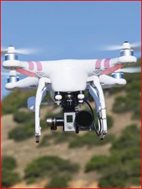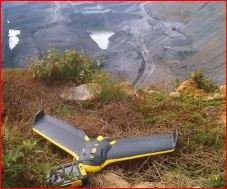An Overview of the Issues
Drones, also known as Unmanned Aircraft Systems (UAS) or Unmanned Aerial Vehicles (UAV) have become the subject of tremendous media interest, controversy and misunderstanding. They are already making a significant impact through commercial applications in a wide range of industries, and are touching the lives of more people every day.



Several industry sectors, including agriculture, energy and construction, have identified unique applications for drones. This expanding commercial use, together with potential humanitarian benefits (e.g., third world medicine delivery or search and rescue missions), will likely win over many of the naysayers. The use of drones as a way to manage risk in many industrial and commercial settings is just beginning. Fitted with highly efficient and smart payloads, UAVs can be the ultimate business tool, combining performance with safety. By replacing people on high ladders or rooftops, or eliminating the need for workers to be high above ground with electric cables or smoke stacks, UAVs can perform tasks with a level of safety far beyond traditional methods.
Privacy and safety, however, are emerging as the two chief concerns that the drone industry needs to address with government officials and the public. While the diverse benefits of drone operation are clear, managing and insuring against risk will be crucial to success for UAV manufacturers and operators.
REGULATION
On February 15, 2015, the Federal Aviation Administration (FAA) released its Notice of Proposed Rulemaking (NPRM), which sets out a framework for the regulation of drones weighing less than 55 pounds in the United States. Many in the industry welcome the proportionate approach the FAA is taking. However, those wishing to operate UAS in excess of 55 pounds, beyond visual line of sight (BVLOS) or over 500 feet above ground level argue that the FAA has not gone far enough to enable the U.S. to lead the way in this rapidly developing global sector.
Before the proposed regulations become law (anticipated to take place in 2017), specific approval to operate a UAS for commercial or business purposes can be obtained from the FAA. This comes in the form of a Section 333 exemption under the FAA Modernization and Reform Act of 2012. Such approvals have been granted for many industry segments and diverse equipment platforms, usage and operating environments. A special section of the FAA’s website (http://www.faa.gov/uas/legislative_programs/section_333/) provides details of how to apply for the exemption as well as records of approvals already granted and those currently under review. The FAA approvals granted to date have set the bar far higher than the NPRM proposes. For example, requirements have included all operators be licensed pilots.
TRAINING
Training for all levels of drone operation is becoming widely available, from an online course for approximately $200 offered by organizations including the Unmanned Safety Institute (unmannedsafetyinstitute.org), to custom training for a corporation’s team of operators. Some insurance providers already require operators to undertake some type of formal training. As the regulations become fully developed, expect training to become mandatory by insurers. The quality of the operating manual and after-sales support available to buyers varies enormously. Some are out-of-the-box ready; others require the owner to assemble parts before taking to the air. Some come with in-depth, easily understandable manuals; most do not. A poorly translated manual plus an inexperienced, untrained operator is a formula for disaster. Important information, such as the relative battery deterioration in cold weather, is missing from many instruction manuals.
ENVIRONMENTAL HAZARDS
One of the greatest hazards in a UAV operation is the ability to operate in close proximity to people. The NPRM outlined the need for drones to avoid flying over people not directly involved in the operation. Common sense, together with the safety culture already discussed, should prevail on this point. Video footage taken by a drone soaring over a wedding party or a concert venue may produce some good imagery; but the risk is simply too great. The failure rate of small drones is still too high to take such chances where the risk of serious injury exists. Many start-up technology companies are working on solutions for these UAV-related risks. Geo-fencing, or the ability to build technology into the software to prevent a drone from flying in restricted airspace, will soon be available to the mass market. Some manufacturers are already integrating it into their products. This technology can prevent flights near airports, government facilities and critical infrastructure as well as congested areas. While further development of the technology is needed, the intention to assimilate these risk mitigation features into UAS products is gaining momentum.
PRIVACY ISSUES
The final key UAS risk factor to consider is respecting people’s privacy. Using drones in a responsible and ethical manner will ultimately lead to a lower risk profile as well as greater public acceptance of this controversial new technology. Simple precautions can be taken to avoid breaching an individual’s reasonable expectation of privacy. These could include gaining the person’s consent to being filmed and taking care not to publish any images or material captured without their consent.
WHY BUY UAS INSURANCE?
Most general commercial insurance policies exclude aviation exposures, including those for drone operators, manufacturers, dealers or service providers. Aviation is a litigious environment. Drone operators may not consider what they are doing to be dangerous (some don’t even consider it to be aviation) but operators of UAVs could be exposed to legal action if damage is sustained to property or injury to persons. This is where professional providers of insurance are so crucial. In the aftermath of an accident, UAS operators will need the support of a trusted insurance provider. Liability insurance doesn’t represent a big cost when considering that the livelihood and reputation of the insured parties are at stake
WHAT WILL A UAS INSURANCE POLICY TYPICALLY COVER?
Aviation insurance falls into two basic categories: 1) legal liability and physical damage (otherwise known as hull) for the owner/operator; 2) and product liability for the manufacturer. An operator should consider legal liability insurance as a minimum. This covers the cost to property repair or injury to persons. Additional coverage may include personal injury (invasion of privacy), non-owned (if you crash someone else’s drone), medical expenses, premises liability and war perils such as damage sustained from a malicious act. Additionally, coverage is available against physical damage to the UAS system itself. This covers the cost to repair equipment, or cover the total loss of either the platform, payload or ground equipment. For the manufacturer or service provider (e.g., training facility, consultant, dealer, software designer), product liability is available. This would provide coverage in the event the insured product is considered to have caused or contributed to a loss. (It would not cover claims that fall under a warranty scenario.) It is important to note that even if a UAV operation is just getting started and is not yet commercially viable as a business, it still risks exposure in the event of an incident, and should have the appropriate insurance coverage.
Don't go Unmanned and Uninsured.
Give us a call or click to chat about your particular needs. Download Application
Insurance underwritten by Global Aerospace, Inc.
Source: Excerpts above from “Sky High Drone Growth Present Challenges and Opportunities”, White Paper published by Global Aerospace, Inc. on November 17, 2016, Author: Chris Proudlove
ABOUT THE AUTHOR Chris Proudlove began his career in aviation insurance in 1990 and has been with Global Aerospace since 2005. In his current role as Senior Vice President, Manager Northeast Regional Office & Complex Risks, Mr. Proudlove is a widely recognized expert regarding insurance initiatives and products for unmanned aviation.